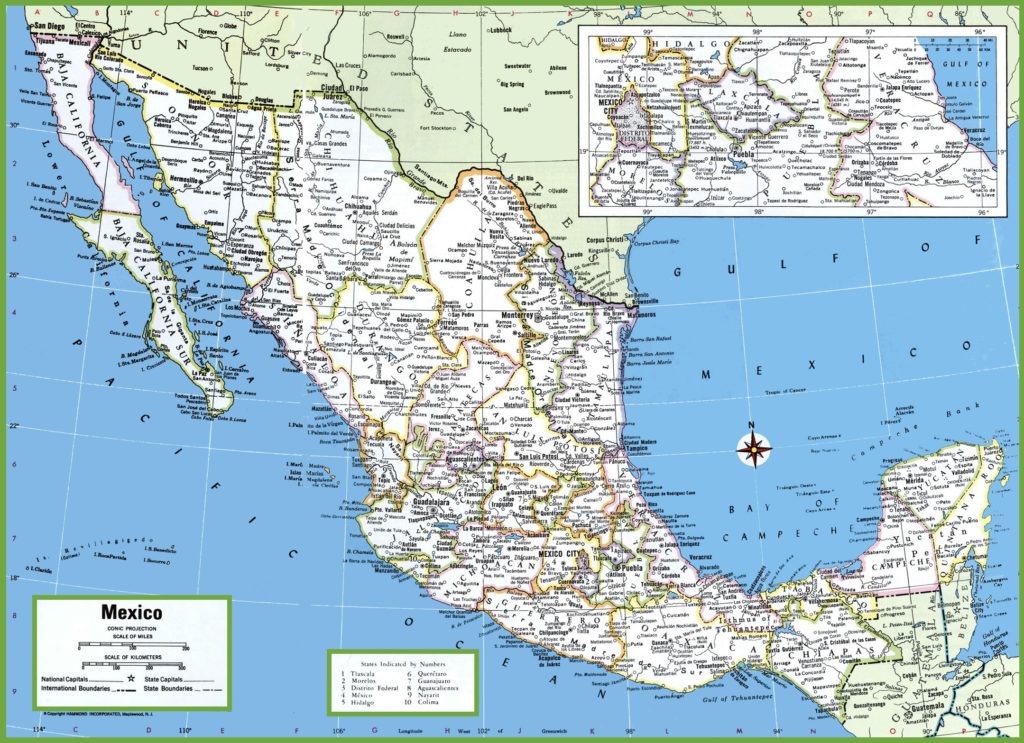Mexico is a country located in North America, sharing borders with the United States to the north and Belize and Guatemala to the south. It is the third-largest country in Latin America, with a population of over 129 million people. Mexico is divided into 32 states, each with its own unique culture, history, and geography.
The states of Mexico are the first-level administrative divisions of the country. They are responsible for local government and administration, including law enforcement, education, and healthcare. Each state has its own capital city, and together they form the United Mexican States.
From the desert landscapes of Baja California to the lush jungles of Chiapas, the states of Mexico offer a diverse range of attractions for visitors. Whether you’re looking to explore ancient ruins, relax on a pristine beach, or sample delicious regional cuisine, there’s something for everyone in this fascinating country. In this article, we will take a closer look at the 32 states of Mexico, their unique characteristics, and what makes them worth visiting.

The 32 States of Mexico
Mexico is divided into 32 states, each with its own unique culture, history, and attractions. Here’s a brief overview of each state:
Aguascalientes
Aguascalientes is known for its hot springs, colonial architecture, and annual San Marcos Fair.
Baja California
Baja California is a popular destination for surfing, fishing, and wine tasting. Its capital, Mexicali, is a bustling border town.
Baja California Sur
Baja California Sur is home to the famous Cabo San Lucas resort area, as well as numerous national parks and marine reserves.
Campeche
Campeche is a UNESCO World Heritage site known for its well-preserved colonial architecture, Mayan ruins, and beautiful beaches.
Chiapas
Chiapas is a mountainous state with a rich indigenous culture and numerous natural wonders, including the Sumidero Canyon and the Palenque archaeological site.
Chihuahua
Chihuahua is the largest state in Mexico and is known for its rugged terrain, cowboy culture, and the stunning Copper Canyon.
Coahuila
Coahuila is a major mining and agricultural state, with attractions including the Saltillo pottery market and the Cuatro Ciénegas nature reserve.
Colima
Colima is a small state known for its active volcano, beautiful beaches, and pre-Columbian ruins.
Durango
Durango is a mountainous state with a rich mining history and numerous natural attractions, including the Basaseachi waterfall and the Sierra Madre Occidental.
Guanajuato
Guanajuato is a colonial gem known for its colorful architecture, underground tunnels, and the famous Cervantino Festival.
Guerrero
Guerrero is a coastal state known for its beautiful beaches, surf spots, and the charming town of Taxco.
Hidalgo
Hidalgo is a small state known for its pre-Columbian ruins, hot springs, and the colonial city of Pachuca.
Jalisco
Jalisco is the birthplace of tequila and mariachi music, and is home to the vibrant city of Guadalajara, the charming town of Tequila, and the stunning Lake Chapala.
Mexico City
Mexico City is the capital of Mexico and is known for its rich history, vibrant culture, and numerous museums and landmarks, including the National Museum of Anthropology and the Zócalo.
Mexico State
Mexico State surrounds Mexico City and is home to numerous charming towns, archaeological sites, and natural attractions, including the Nevado de Toluca volcano.
Michoacán
Michoacán is a colonial state known for its beautiful architecture, the Day of the Dead celebrations in Patzcuaro, and the monarch butterfly reserves.
Morelos
Morelos is a small state known for its hot springs, colonial architecture, and the charming town of Tepoztlán.
Nayarit
Nayarit is a coastal state known for its beautiful beaches, surfing spots, and the charming town of Sayulita.
Nuevo León
Nuevo León is a major industrial state known for its modern architecture, the charming town of Santiago, and the stunning Chipinque ecological park.
Oaxaca
Oaxaca is a colonial state known for its vibrant indigenous culture, the stunning Monte Albán archaeological site, and the famous Day of the Dead celebrations in Oaxaca City.
Puebla
Puebla is a colonial state known for its beautiful architecture, the stunning Cholula archaeological site, and the famous Cinco de Mayo celebrations.
Querétaro
Querétaro is a colonial state known for its well-preserved architecture, the charming town of San Miguel de Allende, and the stunning Sierra Gorda ecological reserve.
Quintana Roo
Quintana Roo is a popular tourist destination known for its beautiful beaches, diverse wildlife, and vibrant culture.
Conclusion
Knowing the 32 states of Mexico is important for anyone who wants to learn about the country’s geography, culture, and history. Each state has its unique characteristics, traditions, and landmarks that make it worth visiting and exploring.
From the beaches of Baja California Sur to the deserts of Chihuahua, from the colonial cities of Guanajuato to the ancient ruins of Yucatan, Mexico offers a wealth of experiences for travelers and locals alike. Whether you are interested in food, music, art, nature, or adventure, there is something for everyone in Mexico’s 32 states.
By learning about the states of Mexico, you can also gain a better understanding of the country’s political and social structure. Each state has its governor, legislature, and judiciary, and has a certain degree of autonomy and responsibility in managing its affairs. At the same time, the federal government has the power to regulate certain areas, such as foreign policy, defense, and immigration.
Overall, the 32 states of Mexico reflect the country’s diversity, complexity, and richness. Whether you are a student, a traveler, a researcher, or a curious person, exploring Mexico’s states can be a rewarding and enlightening experience.
